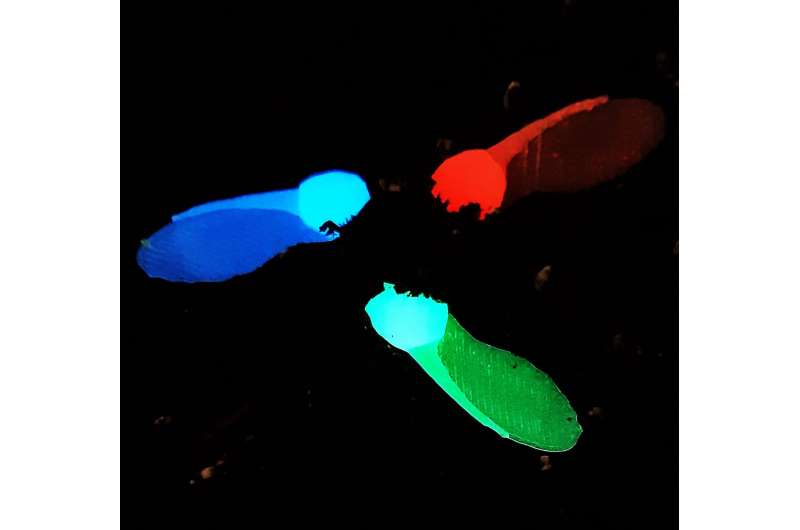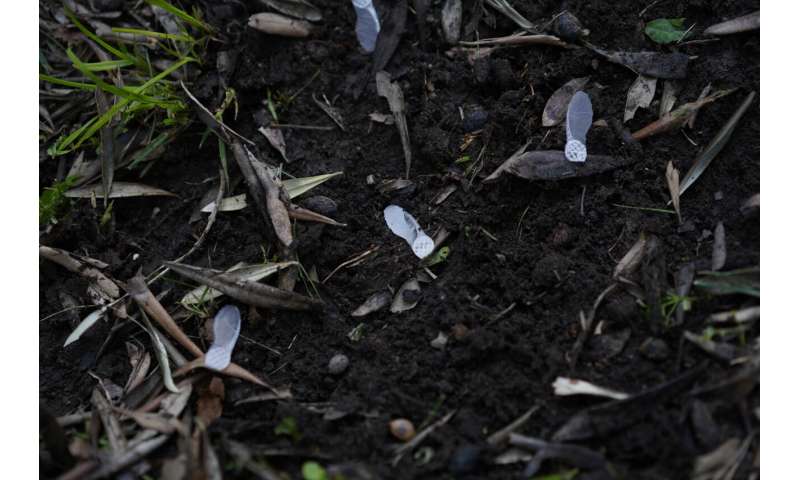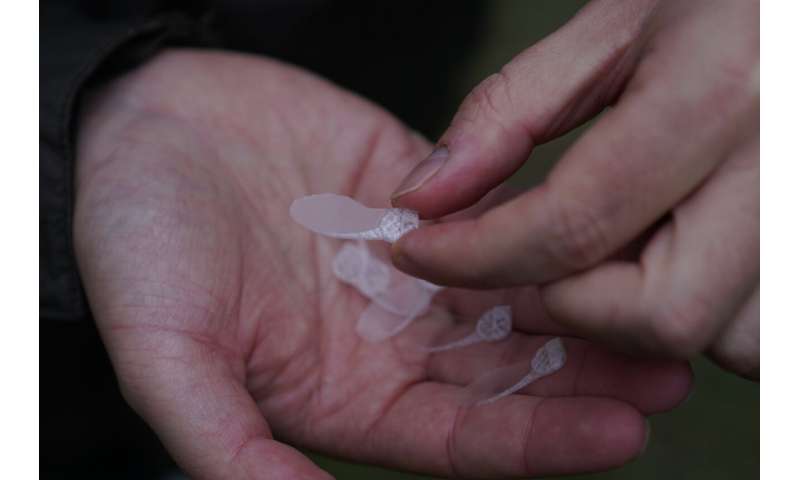This article has been reviewed according to Science X's editorial process and policies. Editors have highlighted the following attributes while ensuring the content's credibility:
fact-checked
trusted source
proofread
The first eco-friendly fluorescent artificial seed for monitoring soil temperature by using drones

Researchers have invented a new kind of artificial seed to sense environmental parameters without impacting the health of the environment.
The soft robot, named Acer i-Seed, is inspired by natural Acer seeds and can monitor the temperature of the soil by becoming luminescent. It is made of a biocompatible and compostable material, and it has been realized with 3D printing technologies. A drone can be used to spread them out in large areas and study the terrain at a distance.
The new Acer i-Seed has been described in the journal Science Advances by the research group led by Barbara Mazzolai at the Italian Institute of Technology (IIT) in Genova (Italy), in collaboration with the Leibniz Institute for New Materials (INM), Saarbrücken, Germany.
The artificial seed replicates the aerodynamic behavior of the Acer campestre seed, an Acer species native to Europe. When mature, these seeds detach from the plant and are carried away and dispersed by the wind over large distances.
Interestingly, these seeds exploit a mono-winged peculiar aerodynamic design that allows them to rotate as a helicopter blade while falling. This autorotation lowers the descent speed and allows the seed to stay more in the air, thus increasing the chances of dispersion by wind gusts. The same seed species was one that perhaps inspired the genius Leonardo Da Vinci to draft his "vite aerea."
Researchers at IIT work in the field of bio-inspired soft robotics, and after mimicking the growth and movement strategies of the roots, climbing plants, and Geraniaceae seeds, the group turned their focus to studying the flying and dispersal features of the structures of the winged Acer seeds.
"This study demonstrates that imitating the strategies or structures of living beings and replicating them in robotic technologies are key elements to obtain innovation with low environmental impact in terms of energy and pollution," said Barbara Mazzolai, Associate Director for Robotics of the IIT and Director of the Bioinspired Soft Robotics (BSR) Lab.
After analyzing the morphology, histology, and aerodynamics of the natural seeds, the researchers designed and realized the artificial biomimetic seed. Then, they developed a biocompatible and compostable material based on polylactic acid (PLA) with embedded non-toxic fluorescent lanthanide particles that are sensitive to the temperature. Finally, they used 3D printing technologies for the fabrication of artificial luminescent seeds.
-

The artificial seed replicates the aerodynamic behavior of the Acer campestre seed, an Acer species native to Europe. After analyzing the morphology, histology and aerodynamics of the natural seeds, the researcher group designed and realized the artificial biomimetic seed. Credit: IIT-Istituto Italiano di Tecnologia -

The new Acer i-Seed is made of a biocompatible and compostable material, and it has been realized with 3D printing technologies. A drone can be used to spread them out in large areas and study the terrain at a distance. Credit: IIT-Istituto Italiano di Tecnologia
The fluorescent artificial seed-like fliers hold potential for deployment by drones equipped with fLiDAR (fluorescence Light Detection and Ranging), enabling remote and distributed monitoring of the soil temperature and other parameters. Researchers have already tested on-field the I-Seed Acer released by a drone, demonstrating its feasibility.
"Moving the sensing into the material obviates power sources and electronics, making the flier eco-friendly and robust," says Tobias Kraus, who leads the development of the flyer's sensor materials at INM—Leibniz-Institute for New Materials.
While this research primarily focuses on thermal sensing, in the future, researchers are considering incorporating fluorescent particles sensitive to other significant environmental parameters, such as humidity, CO2 level, or pollutants.
The next step will be to collaborate with interested companies to use these new soft robots, the Acer i-Seeds, in larger areas, such as agricultural terrains, for a distributed, simultaneous, wireless, and eco-friendly environmental analysis.
More information: Kliton Cikalleshi et al, A printed luminescent flier inspired by plant seeds for eco-friendly physical sensing, Science Advances (2023). DOI: 10.1126/sciadv.adi8492
Provided by Italian Institute of Technology





















